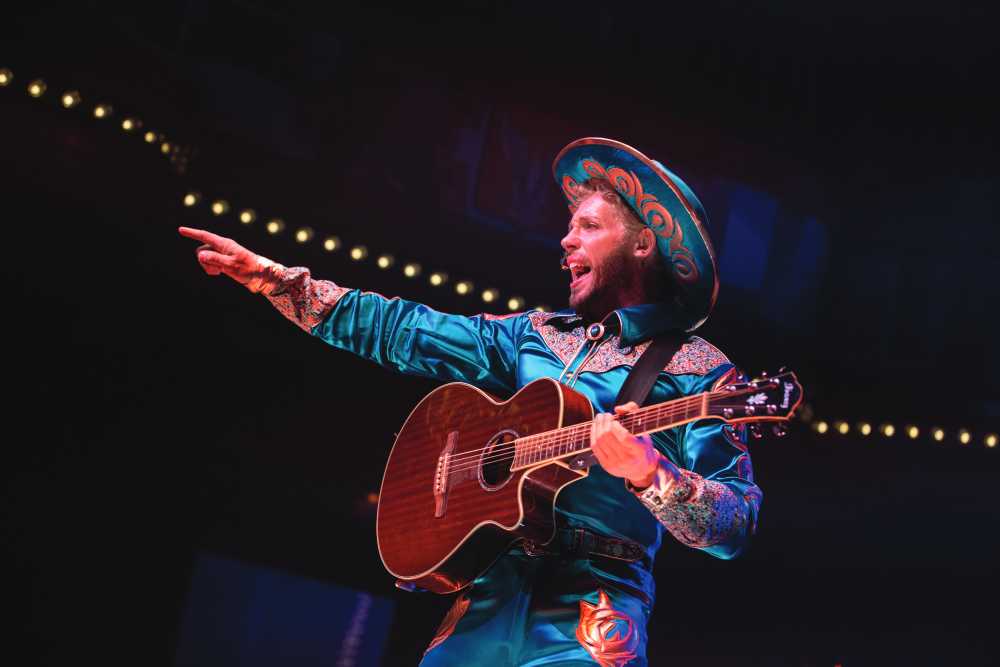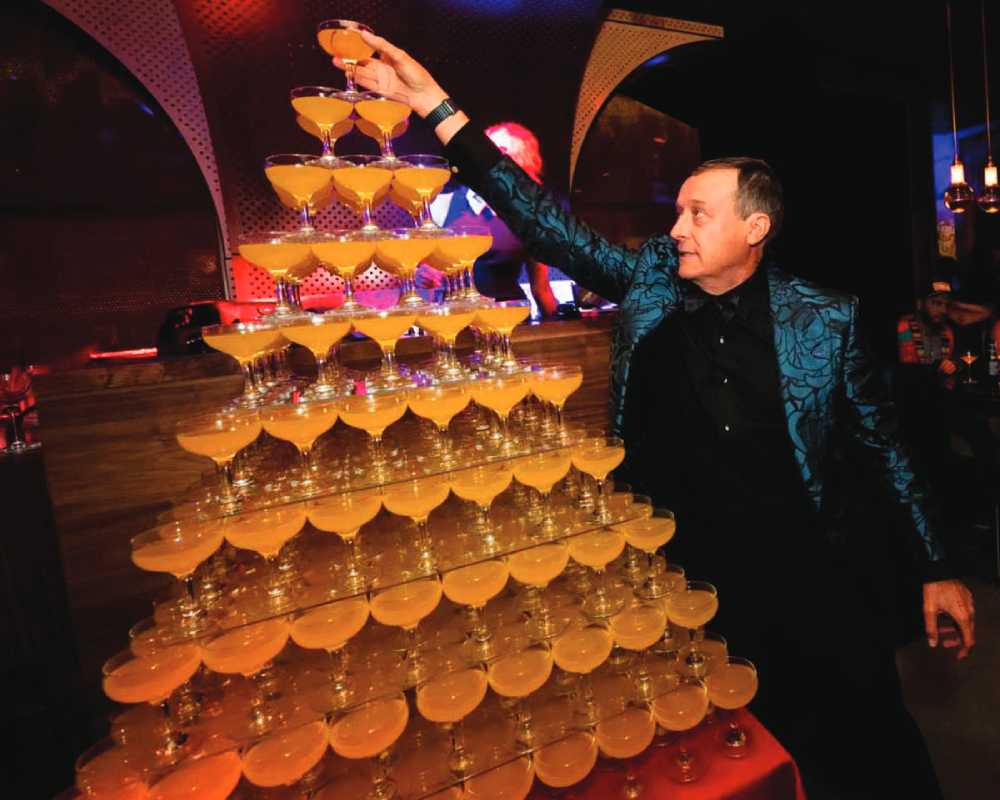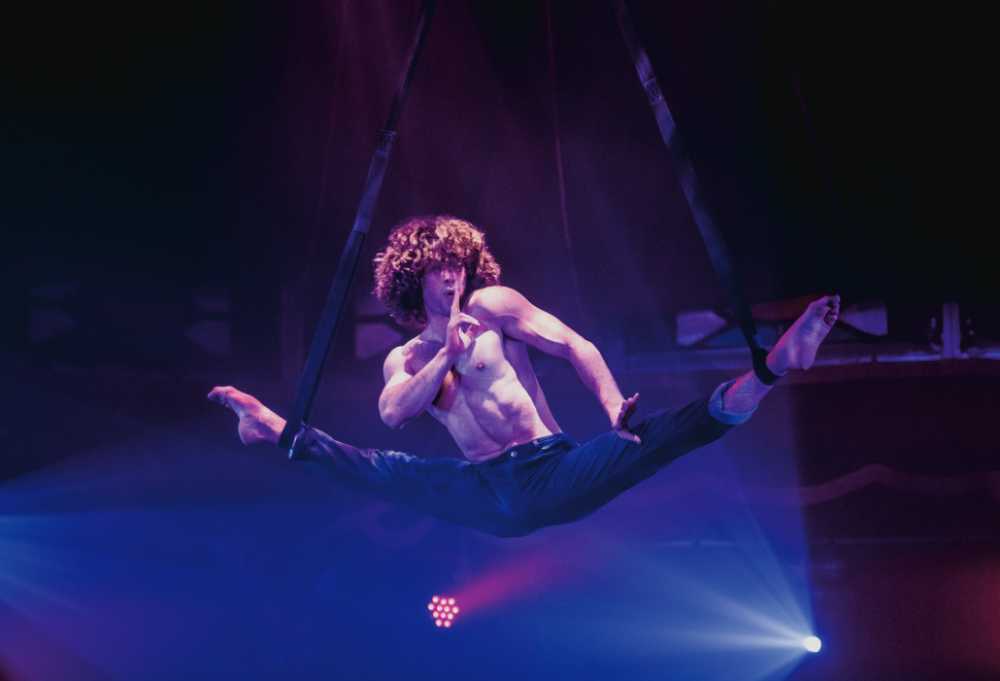Two ripped Polish bodybuilders in grippy white trunks climb one another like human rock formations, do headstands on each others’ shoulders and perform the most impressive of hand jobs, one holding the other aloft on a single outstretched palm.
A strapping DILF lies on his back, knees bent so the soles of his feet face the ceiling. A few feet away, his buff teenage companion springs off the ground, extends himself into an airborne plank and comes in for a perfect landing, taut abs settling atop Daddy’s tootsies, which proceed to kick the young man into high-flying logrolls and flips.
Blue Jackson, a hunky guitar-strumming cowboy whose satin pants and sense of humor notably match his moniker, welcomes a group of gay tourists to his performance, then leads the entire audience in a sing-along salute to the pleasures of analingus.

Blue Jackson in the Atomic Saloon Show (Photo by Erik Kabik for Spiegelworld)
Welcome to the scintillatingly intimate, riotously funny and utterly unprejudiced extravaganzas of Spiegelworld. The production company currently has a trio of distinctly-themed burlesque-meets-circus spectacles running on the Las Vegas strip: Absinthe, its flagship show, in residence beneath a giant tent in front of Caesar’s Palace since 2011; Atomic Saloon, a wild west laugh fest at the Venetian; and OPM (previously known as Opium), a spoofy sci-fi “voyage to Uranus” at the Cosmopolitan.
All three of these shows underscore Las Vegas’ gradual shift away from its insincere late 20th century feint toward family-friendliness—exemplified by the arrival, expansion and ultimate oversaturation of Cirque du Soleil offerings—toward a full-on re-embrace of adult (and arrested-adolescent) pleasures.
But it’s OPM, with a performance space that spills into Superfrico, an “Italian psychedelic” restaurant (which in turn feeds into a ski lodge-themed speakeasy) that reveals the blueprint for the mouthwatering future of Spiegelworld, both in Vegas and beyond.
ONE-STOP NIGHTLIFE
“Its not a small ambition to have a hit show,” says Ross Mollison, Spiegelworld’s founder and self-titled Impresario Extraordinaire. “Or to have a successful bar and restaurant either.”

Ross Mollison at Superfrico Opening Night Party in Las Vegas (Photo by Spiegelworld)
While Mollison’s primary professional expertise is in theatrical production and promotion, he’s long considered himself a “restaurant dilettante,” game to travel the world in search of the most exciting gastronomic experiences. For the next course in his career, Mollison aims to make food and drink a major part of his act.
“My first restaurant was ‘Rose, Rabbit, Lie’,” he recalls, describing a prior, incarnation of the Superfrico/OPM venue. “That didn’t end well for me.”
“I think the menu was just too elevated and the price point a bit high, so it started to have a sort of supper club vibe. That’s fine, but it felt a bit Grandma. I haven’t gotten my first strand of pearls yet and, personally, I want more energy than that.”
In going back to the drawing board to conceptualize Superfrico, Mollison leaned on the same instinct for talent wrangling that’s helped him track down and contract the world’s best variety performers for his stage shows, whether they hail from Coney Island, Ukraine, or Ethiopia.
He brought in internationally recognized “pizza czar” Anthony Falco to help develop the menu which features both round and square pies, the latter including a pillowy-doughed signature selection topped with house-made stracciatella cheese, mortadella and pistachio pesto.
A theatrical mozzarella service includes fresh curds pulled tableside; and Falco’s phenomenal chicken parm features an unlikely Japanese accent, the thin-pounded organic breasts marinated in ponzu sauce and breaded with a combination of sourdough crumbs and shatteringly crisp panko.
Mollison also tapped mixologist Leo Robitschek, an alumnus of New York’s 11 Madison Park, to develop two entirely different cocktail menus for the dining room and the Ski Lodge bar.
“We want to create experiences where you can go out to one place for the night and just know you’re going to have a fantastic time, whatever you’re in the mood for. The food is going to be incredible. You’re going to want to try every cocktail, because they’re amazing. The entertainment will be great.”
In Las Vegas, OPM ticket holders can hang out at Superfrico or the Ski Lodge for a bite or drinks pre- or post- performance. On a tighter schedule? There’s always the option of having a hot pizza delivered to your theater seat. Or skip the sit-down show for the venue’s other amusements: walls decked out with an eclectic gallery of modern art, a vinyl-spinning DJ and guerilla tableside schtick from a close-up magician, crowd-working comic, or giant furry twerker. And there’s never a cover.
Since opening in the fall of 2021, Superfrico has proved a huge draw for both locals and tourists. In the wake of its success, Caesar’s Entertainment has placed a major bet on Mollison’s winning combination of showbiz, drinking, and dining, committing $75 million to open new Spiegelworld restaurant/production outposts in Atlantic City and New Orleans, plus an additional Las Vegas operation.
THE BUDDING RINGMASTER
It was the Moscow Circus that first wet Ross Mollison’s appetite for spectacle when he was growing up in Melbourne, Australia. Family friends were involved in producing the troupe’s antipodean tours. “When you’re a six year old kid nothing could be more exciting,” recalls Mollison. “It was really a Russian circus back then.”
“Now its just a brand, and not necessarily such a good brand,” he jokes. “Today, the Moscow circus is touring in Australia and advertising ‘No Russians! All Mexican cast!’”
“When I was sixteen, I was on holiday in New York and saw the Ringling Brothers circus at Madison Square Garden and that made an incredible impression on me as well.”
While it was years before Mollison first oversaw his own ensembles of aerialists, contortionists, and other circus performers, he remained enamored with show business throughout his childhood and teen years.
“I went to this prep school called Scotch College,” he reminisces. “It was all boys. Very strict. You had to wear a suit every day. But they were really big on music and theater, which was fantastic. Every year we’d do a play. I remember playing a role in Ionesco’s Rhinoceros and having no idea what the show was about. But I loved doing it”
“Then, at college in Melbourne in the ‘80s, there was lots of musical theater. We’d do Hello Dolly, and Sweet Charity and West Side Story. That’s when I discovered that I really loved back of the house work, producing and promoting things.”
It was also in college that Mollison first began collaborating with Andrew Dunn, a partnership that continues today, with Dunn serving as Spiegelworld’s creative director.
“For our school holidays,” says Mollison, “Andrew and I would build children’s shows, which were easy to sell and we’d take them around Australia. That’s really what got us started in business. We turned out to be so good at promoting and getting audiences that our university hired us to do the publicity and marketing for the professional theater season they ran.”
Thus was born Mollison Communications, the pair’s initial post-collegiate enterprise, which found them successfully promoting Australian tours of middlebrow theatrical fare, including Cats and Shirley Valentine, before landing the first of two projects that would be critical in paving the way to Spiegelworld.
“We promoted Cirque du Soleil in New Zealand and Australia for about ten years,” explains Mollison. “They were the biggest, the best and the most exciting live production company in the world at that time, a truly global business. And nobody has really managed anything of that scale since.”
While developing know-how and contacts within the arcane world of circus performers over the years, Mollison began to think about how Cirque-style shows might evolve in the future.
“Everything was getting bigger and bigger,” he remembers. “They were moving from tents into arenas. It seemed to me there was an opportunity to take things smaller, to presenting acts with equivalent skill at a more intimate scale.”
“Instead of having a trapeze routine with 20 people in it, what about five or three or two people with the same level of talent, but on a stage the size of your dining room table with the entire audience up close to the action?”
A PACKAGE TOUR
In 2001, as Mollison continued to muse over alternative circus formats, he licensed the rights to an altogether different sort of theatrical exhibition.
Puppetry of the Penis is perhaps best described as genital manipulation without masturbation. The show, originally presented at the Melbourne Fringe Festival in 1998, features two male actors wearing only sneakers and superhero capes who fold, twist and squash their junk into soft sculptures with names like “the hamburger,” “the atomic mushroom,” and “the flying squirrel” while onstage cameras project enlarged views of the action onto a screen above the stage.

Jean-Louis in Atomic Saloon Show (Photo By Spiegelworld)
“That’s how I learned America,” marvels Mollison. “I went around with that show, which cost us nothing to produce. It was the merest excuse of an entertainment, about five minutes of material literally stretched out for 90 minutes, but it was so novel that people would turn up for it. And pay 50 bucks.”
After short stints around the country, Mollison booked the act into New York’s John Houseman Theater for an open-ended engagement that began, inauspiciously, in October, 2001. But as it turned out, the show proved an escapist balm for a stressed out city and Puppetry had a successful run of more than a year. (While Mollison is no longer involved with Puppetry, a production of the show currently plays four nights a week in Las Vegas).
For his follow-up New York project, Mollison produced the 2004 Off-Broadway debut of Slava’s Snow Show, a showcase for the visual comedy of Russian expat clown Slava Polunin, a Cirque du Soleil veteran. An enormous hit with family audiences, Snowshow was a financial success, running for nearly two and a half years and helping plow a clear road forward for Mollison. For his next act, he would merge the raunchy humor and circus heritage of his first two New York productions to create the gritty sort of spectacle he’d been imagining for years.
THE TENT GOES UP
In the 19th and early 20th centuries, traveling entertainers toured Europe with their own showplaces in tow. These collapsible spiegeltents, or mirror tents, constructed from wood and canvas were the smaller, swankier cousins of dirt-floored circus big tops. Hung with mirrors to create a greater sense of interior volume and often featuring polished wooden dance floors, they provided sumptuous venues for itinerant musical ensembles and cabaret performers.
In the summer of 2006, Ross Mollison pitched his first spiegeltent alongside the East River in the unfashionable South Street Seaport neighborhood of Manhattan and mounted the first iteration of Absinthe, introducing the type of edgy, up-close variety show that Spiegelworld has built its brand on.
Seated just feet away from the stage, audience members could observe the taut, stretched carotid artery on the lady sword swallower’s neck and feel the spray of water and perspiration as an aerialist dipped in and out of an onstage bathtub while swinging from a trapeze. Hosting the festivities was a vulgar emcee character known as the Gazillionaire, who still rules the roost at Las Vegas’ Absinthe today.
Reading like Mollison’s dream come true, the New York Times review of the show likened it to “Cirque du Soleil as channeled through The Rocky Horror Picture Show.”
After two additional summers in New York, Absinthe eventually made its way to a new, custom-built spiegeltent in Las Vegas, where it attracted sell-out crowds and celebrity fans. In 2016, just five years after it opened on the Strip, Las Vegas Weekly ranked Absinthe #1 on a list of the top 20 shows in Las Vegas history, besting not only five Cirque du Soleil productions, but icons like David Copperfield and Siegfried & Roy.
Next time such rankings are tallied, Absinthe will undoubtedly jostle with younger Spiegelworld siblings for the top spot.
“I think one of the competitive advantages we have,” says Mollison, who remains a keen observer of Cirque du Soleil, “is that, while we’re growing, we’re making sure that our offerings don’t feel homogenous. I think the experiences you have at OPM and at Atomic Saloon feel very different.
For Atomic Saloon, Mollison and creative director Dunn brought on acclaimed gay British director Cal McCrystal, a physical comedy specialist who created the slapstick body language and pratfalls for James Corden’s Tony-winning performance in One Man, Two Guvnors. As Atomic’s buffoonish frontier-era characters take precarious tumbles from their tiny stage, alchemizing clumsiness into acrobatic finesse, McCrystal’s mark is unmistakable.
Projected to open at the Linq by the middle of next year, the forthcoming DiscoShow, in which audience members and performers will share a dancefloor surrounded by kaleidoscopic LED video walls, is being staged by Steven Hoggett, whose sweeping choreography brought Harry Potter & The Cursed Child and Green Day’s American Idiot to life on Broadway. Overseeing the music is super producer Nile Rodgers. The performance space will reside within Spiegelworld’s first post-Superfrico restaurant endeavor, called Glitterloft.
SEASIDE REVIVALIST
While Mollison is still working out details of Spiegelworld’s theater/restaurant complexes at Caesar’s resorts in Atlantic City and New Orleans, he’s particularly pumped about the Jersey Shore opening, which, with luck, will happen in the first half of 2023. “We’re going to be the only permanent production show in Atlantic City, running 52 weeks a year,” he says.
Spiegelworld’s venue, a 430 seat show room plus a 150 seat restaurant, is being built on the former site of the Warner Palace Theater, a colossal movie auditorium that opened in 1929, was converted to a bowling alley in the 1950s and was torn down to make way for a parking garage in the 1980s. While the theater’s interior was entirely demolished, its ornate Moorish façade was spared.
Opening directly onto ocean views across Atlantic City’s famous boardwalk, it will once again serve as the entryway to a showplace, perhaps helping usher in another revival of this perpetually up and-down town.
Not so long ago Mollison saw producing a successful show in New York as a major professional milestone, but this faded seaside resort now stirs up a familiar urge; the one that led him to strategize like David against Cirque du Soleil’s Goliath.
“There are a lot of people within an hour’s drive of Atlantic City who go to Manhattan for their entertainment. And you know,” he quips with an arch of his eyebrow, “Its fair to say that Manhattan has a pretty good entertainment offering.”
“So we’re going have to do something to compete with Manhattan, something that’s really different and fun and gives people a reason to come. I’m confident that we can do that.”
